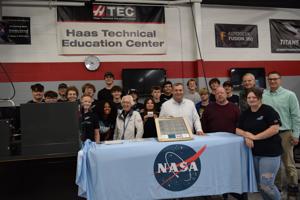URGENT UPDATE: Researchers from the University of Tokyo have just announced a groundbreaking method to diagnose diseases using just a droplet of blood, a standard microscope, and cutting-edge artificial intelligence. This innovative technology could revolutionize medical diagnostics worldwide, making testing faster, cheaper, and more accessible than ever before.
In a study published in the journal Advanced Intelligent Systems, the team has developed a high-throughput system that analyzes the drying process of biofluid droplets—such as blood, saliva, and urine—to accurately identify diseases. This method drastically reduces the need for traditional blood draws, which typically require 5 to 10 milliliters of blood, often necessitating painful and inconvenient visits to medical facilities.
“Our goal was to create a simple, rapid, and reliable approach to analyze blood samples,” said Miho Yanagisawa, associate professor at the University of Tokyo. The researchers focused on the entire drying process of droplets, revealing critical information about the fluid’s composition beyond just the final pattern left behind.
Utilizing machine learning algorithms, the team can decode the dynamic changes that occur during the drying of blood droplets. This allows them to differentiate between healthy and abnormal samples based solely on their drying behavior. Remarkably, this technique can be executed without specialized equipment, using only a brightfield microscope and a standard 4x objective lens.
The implications are profound: by eliminating the need for invasive phlebotomy services, this technology could enable widespread implementation of diagnostic tests, especially in developing countries where healthcare resources are limited. The researchers envision a mobile health-screening tool that could facilitate early disease detection and preventive care, making health monitoring quicker and more affordable for communities with restricted access to laboratory testing.
“This approach opens up a new way of thinking about medical diagnostics,” noted Anusuya Pal, a postdoctoral research fellow and the study’s lead author. “Each moment of the drying process holds valuable clues, capturing a dynamic ‘story’ of the sample’s internal state.”
The team has demonstrated proof of concept for detecting conditions such as diabetes, influenza, and malaria, showcasing the potential for this method to transform global health standards.
Looking ahead, Amalesh Gope, co-author of the study, emphasized the importance of translating this technology into practical applications: “Our ultimate goal is to bring laboratory-level insights to the point of care, enabling early detection and preventive health care for everyone.”
As this groundbreaking research unfolds, the medical community and global health advocates are watching closely. This innovative approach not only aims to improve diagnostic accuracy but also seeks to democratize healthcare access, potentially saving countless lives around the world.
For more details on this pioneering study, refer to the paper by Anusuya Pal et al, titled From Droplet to Diagnosis: Spatio‐Temporal Pattern Recognition in Drying Biofluids, published in Advanced Intelligent Systems (2025). DOI: 10.1002/aisy.202500550.







